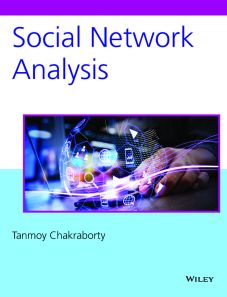Social Network Analysis
ISBN: 9789354247835
400 pages
Publication Year: 2021
For more information write to us at: acadmktg@wiley.com

Description
This book covers the content, keeping in mind the CS, IT and SS academic curricula for undergraduate and fresh graduate students. The coverage of the book has the right balance of the mathematical foundations and technological aspects of social networks, along with several applications of mining social network data. This book perhaps is the first of its kind that succinctly covers a set of critical fundamental concepts (theory) and offers detailed coverage of recent advances (practice). Additional online material (source codes, datasets, blogs, exercises, etc.), accompanying the chapters, along with quizzes and data challenges will strengthen the theoretical and practical skills of the students and professionals. More details of these resources and the book can be found at social-network-analysis.in.
Endorsements
Foreword
Preface
Acknowledgements
1 Networks and Society
1.1 What is Social Network Analysis?
1.2 Why do We Study Social Networks?
1.3 Applications of Social Network Analysis
1.4 Preliminaries
1.5 Three Levels of Social Network Analysis
1.6 Historical Development
1.7 Graph Visualisation Tools
1.8 Chapter Summary
2 Network Measures
2.1 Network Basics
2.2 Node Centrality
2.3 Assortativity
2.4 Transitivity and Reciprocity
2.5 Similarity
2.6 Degeneracy
2.7 Chapter Summary
3 Network Growth Models
3.1 Properties of Real-World Networks
3.2 Random Network Model
3.3 Ring Lattice Network Model
3.4 Watts–Strogatz Model
3.5 Preferential Attachment Model
3.6 Price’s Model
3.7 Local-world Network Growth Model
3.8 Network Model with Accelerating Growth
3.9 Aging in Preferential Attachment
3.10 Chapter Summary
4 Link Analysis
4.1 Applications of Link Analysis
4.2 Signed Networks
4.3 Strong and Weak Ties
4.4 Link Analysis Algorithms
4.5 PageRank
4.6 Personalised PageRank
4.7 DivRank
4.8 SimRank
4.9 PathSIM
4.10 Chapter Summary
5 Community Structure in Networks
5.1 Applications of Community Detection
5.2 Types of Communities
5.3 Community Detection Methods
5.4 Disjoint Community Detection
5.5 Overlapping Community Detection
5.6 Local Community Detection
5.7 Community Detection vs Community Search
5.8 Evaluation of Community Detection Methods
5.9 Chapter Summary
6 Link Prediction
6.1 Applications of Link Prediction
6.2 Temporal Changes in a Network
6.3 Problem Definition
6.4 Evaluating Link Prediction Methods
6.5 Heuristic Models
6.6 Probabilistic Models
6.7 Supervised Random Walk
6.8 Information-theoretic Model
6.9 Latest Trends in Link Prediction
6.10 Chapter Summary
7 Cascade Behaviours and Network Effects
7.1 Preliminaries and Important Terminologies
7.2 Cascade Models
7.3 Case Study – The “Indignados” Movement
7.4 Probabilistic Cascades
7.5 Epidemic Models
7.6 Independent Cascade Models
7.7 Cascade Prediction
7.8 Chapter Summary
8 Anomaly Detection in Networks
8.1 Outliers versus Network-based Anomalies
8.2 Challenges
8.3 Anomaly Detection in Static Networks
8.4 Anomaly Detection in Dynamic Networks
8.5 Chapter Summary
9 Graph Representation Learning
9.1 Machine Learning Pipelines
9.2 Intuition behind Representation Learning
9.3 Benefits of Representation Learning
9.4 Criterion for Graph Representation Learning
9.5 Graph Representation Learning Pipeline
9.6 Representation Learning Methods
9.7 Chapter Summary
10 Applications and Case Studies
10.1 Malicious Activities on OSNs
10.2 Sockpuppets in OSNs
10.3 Collusion on Online Social Networks
10.4 Modelling the Spread of COVID-19
10.5 Recommender Systems
10.6 Chapter Summary
Index

